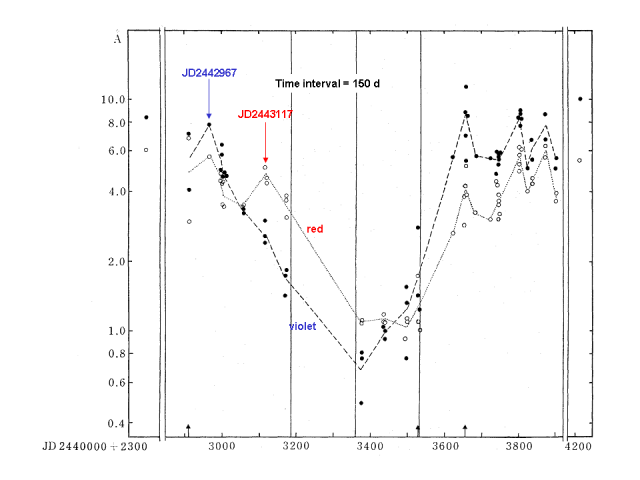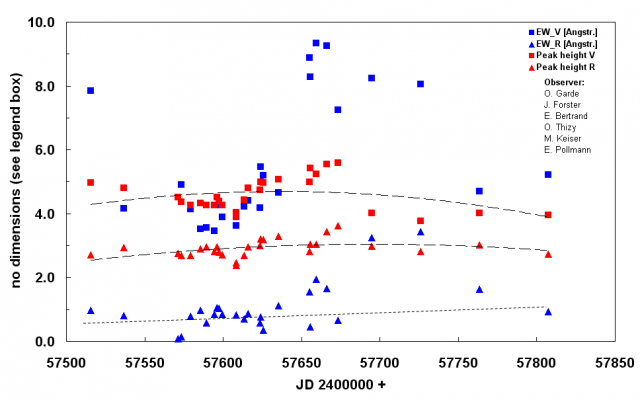› Forums › Spectroscopy › Radius Estimation of VV Cep´s disk
- This topic has 26 replies, 5 voices, and was last updated 8 years, 5 months ago by
 MARC TRYPSTEEN.
MARC TRYPSTEEN.
-
AuthorPosts
-
9 April 2017 at 6:44 pm #573729
 Ernst PollmannParticipant
Ernst PollmannParticipantDear colleagues,
I would like to ask, whether there is a certain interest in a campaign to estimate or calculate the radius of the accretion disk of VV Cep.
High resolved Halpha spectra, how they are currently received by different observers, do provide the opportunity in August this year, to perform such high interesting goal.
At the beginning of the eclipse, we could observe, the different beginning of the decrease of the intensity of the Halpha emission components V and R. Based on radial velocity measurements of the central absorption core of Halpha, one could calculate the effective radius of the accretion disk of the B companion.
The enclosed Fig. decribes the equivalent widths of the violet (filled circles) and red (opne circles) component of the Halpha emission as function of the Julian Date.
 This had been done in the past by Möllenhoff & Schaifers 1978 & 1981, A&A 64, 253-258 and A&A 94, 333-337, and by Kawabata et al. 1981, Publ. Astron. Soc. Japan, 33, 177-188.
This had been done in the past by Möllenhoff & Schaifers 1978 & 1981, A&A 64, 253-258 and A&A 94, 333-337, and by Kawabata et al. 1981, Publ. Astron. Soc. Japan, 33, 177-188.It would be great, if this interesting aspect in observation of VV Cep would get a certain attention.
Ernst Pollmann
10 April 2017 at 10:42 am #578104 Dr Andrew SmithParticipant
Dr Andrew SmithParticipantHi Ernst, nice idea not that I have tried observations in August before as it never gets really dark.
What is the minimum resolution required and how often are spectra needed?
Thanks Andrew
10 April 2017 at 1:42 pm #578105 Ernst PollmannParticipant
Ernst PollmannParticipantHi Andrew,
I think, the minimum resolving power should be around 12000. I don’t know your location, but at the beginning of August during midnight is the star near zenith and it should be possible to take spectra.
Ernst
10 April 2017 at 2:19 pm #578106 Dr Andrew SmithParticipant
Dr Andrew SmithParticipantJust a bit to high for my R ~ 9000 echelle. I am not sure I will finish the R ~ 20000 in time but if I do I will join in. I am sure some LHires III users will join you.
Regards Andrew
11 April 2017 at 7:37 pm #578114 Andy WilsonKeymaster
Andy WilsonKeymasterThat is an interesting campaign Ernst.
I’d like to get involved if I can, though my own observing has been significantly curtailed this year due to other commitments. If things settle down over the Spring/Summer then I’ll add it to my target list so that I can contribute.
Best wishes,
Andy
11 April 2017 at 8:22 pm #578115 Ernst PollmannParticipant
Ernst PollmannParticipantHi Andy, it would be really great if you could contribute with your spectra to that campaign. But you have to know, it will be fairly important to get a sufficiently long baseline before the eclipse of the V and R component, in order to determine precisely enough the intensity decrease of the emissions.
Ernst
12 April 2017 at 8:25 pm #578121 Andy WilsonKeymaster
Andy WilsonKeymasterHi Ernst,
Thanks for the information which is useful to know. I’ll try to get an observing session in soon on VV Cep. If that doesn’t work out then I may use my limited observing time on Be stars which are well suited to an occasional spectrum when time allows.
Best wishes,
Andy
14 April 2017 at 3:38 pm #578127 MARC TRYPSTEENParticipant
MARC TRYPSTEENParticipantDear Ernst,
Very interesting campaign, which could be abbreviated as VV CEC 2017-19.
For this year observation highlights are the first contact, expected around August 4th and the second contact around October 27th. For the period July/August/September the constellation will be well placed to do HR (R>10.000) spectroscopy. So I could already do some preliminary tests to check the baseline behaviour with a LHIRES and also a SQUES echelle spectrograph. Currently we are in the middle of garden/observatory renovations, so I hope my observatory will be fully operational again in the first part of May.
I wondered if there is (or will be) a video animation/computer simulation available to show the movements of both components of VV Cephei together with an impression of the movements of the accretion disk based on the actual knowledge?
Kind regards,
Marc.
14 April 2017 at 8:56 pm #578128 Mr Jack MartinParticipant
Mr Jack MartinParticipantErnst,
My baseline of observations start from 2105-08-26 to date, a long term study, I intend to contribute scientifically useful data.
Regards,
Jack
Essex UK
15 April 2017 at 5:16 pm #578132 Ernst PollmannParticipant
Ernst PollmannParticipantDear Marc, your possibilities to start at the beginning of May with high resolved observations sounds really good. I would be really happy, if you could contribute with such a kind of spectra. The more spectra we collect, the more precisely would be the estimation, of the time differences of the V and R eclipse. Probably I will be able to take my first spectra at the earliest in the middle of May. I designed an animation for an object related seminar in May at the University of the city of Wuppertal, in order to demonstrate in priciple the process of the eclipse. But unfortunately is not allowed to upload ppt files here. If you are interested, I could send it via email.
Ernst
15 April 2017 at 5:23 pm #578135 Ernst PollmannParticipant
Ernst PollmannParticipantHi Jack, I think every high resolved Halpha spectrum from now, will be a benefit for the campaign.
Ernst
15 April 2017 at 5:39 pm #578136 MARC TRYPSTEENParticipant
MARC TRYPSTEENParticipantThat’s excellent news, Ernst, I’m certainly interested in such an animation ppt. You can send it by email, of course. Many thanks in advance !
A good idea could be to prepare already an upload corner in the BAA Spectroscopy Database? Or, if you have another proposal you prefer?
Kind regards,
Marc
15 April 2017 at 6:44 pm #578137 Ernst PollmannParticipant
Ernst PollmannParticipantHi Marc, there is already an upload opportunity for VV Cep at the database. I think it’s not necessary to creat another one. Please send me your email adress for sending the ppt file. You can find my email adress at my website:
http://www.astrospectroscopy.de
Ernst
16 April 2017 at 9:52 pm #578138 Mr Jack MartinParticipant
Mr Jack MartinParticipantErnst,
My last observation was on 2017-04-01.
Regards,
Jack
Essex UK
17 April 2017 at 9:19 am #578139 Ernst PollmannParticipant
Ernst PollmannParticipantJack, I’m preparing at present a plot of the time behavior of the peak height & equivalent width of the V and R component, in order to get a first impression of the baseline. The last measurement in that plot is from Februar 22th this year. So it would be great, if you could offer your spectrum soon to supplement the base line.
Ernst
17 April 2017 at 3:36 pm #578140 Ernst PollmannParticipant
Ernst PollmannParticipantDear colleagues, I have tried, from spectra of different observers to find base lines of the Halpha emission components V & R out of eclipse. At least the peak heights of both seems to provide a good chance to determine the exact beginning of the eclipse. The dispersion of the measurements comes from the “natural” activities of mass transfer from the M2 super giant into the B star disk (EW & V/R variability). Comments are welcome!

Ernst
17 April 2017 at 5:26 pm #578141 MARC TRYPSTEENParticipant
MARC TRYPSTEENParticipantIndeed, Ernst, the trend of the peak heights “best fitting curve” seems to be a converging one. Perhaps it could also be a shadowing effect as a result of periodically higher mass transfer, (even cyclic ?). Anyway from “57700” a more significant trend is developing. One could also make a plot of V against R and compare it to the same for the EW’s.
Looks very promising! Nice work!
BTW, interesting programs to study ecliptic binaries are: BinSim: http://www.phys.lsu.edu/~rih/binsim/
and PHOEBE: http://phoebe-project.org/1.0/ both running on Unix/Linux/ Ubuntu and Windows platforms.
Kind regards,
Marc.18 April 2017 at 9:34 am #578142 Ernst PollmannParticipant
Ernst PollmannParticipantHi Marc, actually the Halpha V&R and V/R are high variable parameters with a certain periodic behavior. Please have a look to the investigation we recently published at IBVS No. 6156
http://astrospectroscopy.de/media/files/IBVS_6156-02.pdf
The source of the variability of Halpha, originating from an accretion region around the hot companion, remains unclear and the time sampling of these Halpha observations are too sparse to permit a meaningful period analysis. See our IBVS publication No. 6198:
http://ibvs.konkoly.hu/pub/ibvs/6101/6198.pdf
Best wishes, Ernst
18 April 2017 at 3:12 pm #578143 MARC TRYPSTEENParticipant
MARC TRYPSTEENParticipantMany thanks, Ernst, highly interesting !
Indeed developing a model for V/R variability in case of VV Cep needs more measurements. Therefore the upcoming campaign for VV Cep is very important. Additionally,in case of other eclipsing binaries possible ideas applicable to the VV Cep system can be transferred. Most recent concerns a 3D modelling of the accretion disc in an eclipsing binary, here V1239 Her :
https://arxiv.org/pdf/1702.00587.pdf
I wondered also if VV Cep has already been subject of asteroseismologic studies/recordings, as spectroscopy is limited to the line of sight observation.
Kind regards,
Marc.
20 April 2017 at 9:26 am #578145 Ernst PollmannParticipant
Ernst PollmannParticipantAs far as I am informed, are there no investigation in that direction, Marc.
Ernst
-
AuthorPosts
- You must be logged in to reply to this topic.
